How Much Weight Can Drywall Anchors Hold?
-
Pete Ortiz
- Last updated:
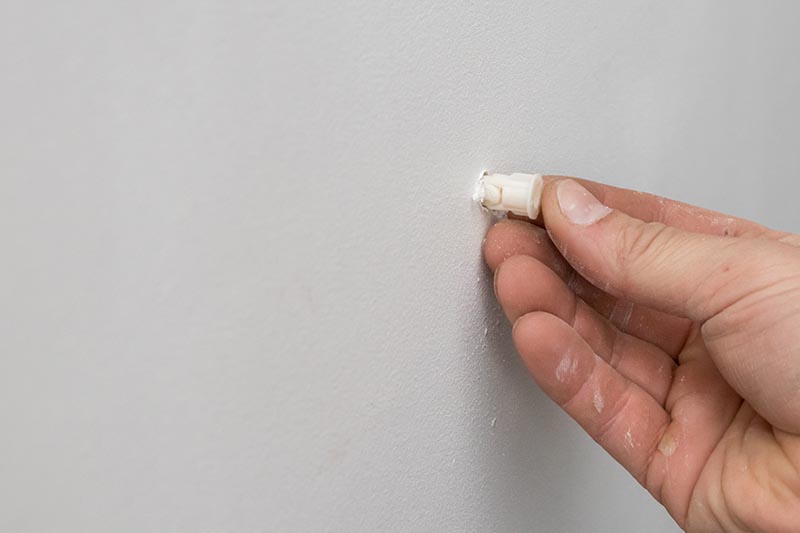
Instead of plastering walls, safety compliance calls for a fire-resistant material that can allow people to escape safely in emergencies. Drywall is durable and pliable for walls and ceilings, often utilized to build architectural styles like eaves, arches, and others.
Installing drywall is quick and straightforward, with minimal damage repairs, besides cutting weeks in wall plastering time. Using anchors, you can also mount paintings, cabinets, shelves, and TVs on the wall, but how much weight can they hold?
Understanding how much weight drywall anchors can hold will help your home’s improvement or aesthetic design. Read on to learn how to attach hangings, including wall art safely, and what limits your drywall can support.
Can Drywall Hold Weight?
Your drywall should not stop you from improving the aesthetics or functionality of a room with hanging décor such as wall art, cabinets, and shelves. If you use the correct technique and hardware, you can determine where and how to mount the weight depending on the anchor’s holding capacity.
Initially, you’ll need to plan first since it’s essential to figure out how much weight drywall anchors hold, as a thin one will drop your wall fixtures. That is because drywall is brittle, unlike wood, brick, and plaster, and does not hold reliably when weight is distributed vertically.
The weight a drywall anchor will hold depends on several factors, including your wall’s thickness and the anchor’s load-bearing capacity. Instead of hanging on hollow sections, vertical framing members called studs, placed 16 to 24 inches apart, are the best locations to hang weight off drywall.
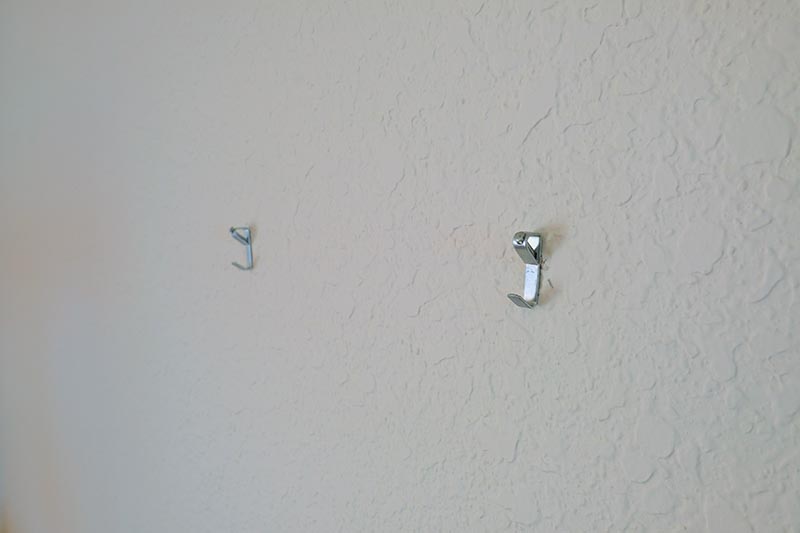
So, How Much Weight Will Drywall Anchors Hold?
You can hold up as much as 20 pounds depending on what you hang with well-placed and long enough drywall anchors. If you fixed your 1 ½ inch nails or size 4D where the wall studs are at a 45° angle, the anchors could support a medium to large picture frame.
Anchoring nails in a stud will let you support a wall light or small planter on your drywall, but screws also give excellent holding power. If you choose a screw penetrating at least 1 inch into the stud, you’ll hold up 40 pounds without trouble.
On the ceiling, however, a regular 2 X 4 joist won’t safely hold more than 15 or 20 pounds regardless of hanging hardware. That is the weight of a 5-inch flower pot combined with soil, water, a plant, or a small ceiling fan. You’ll require further reinforcing with 2 X 6 or 2 X 8 joists, especially for anything that exerts extra pressure with movement, up to around 30 pounds.
Common Types of Drywall Anchors and Their Holding Capacity
Depending on the material, size, and fastening approach, there are several kinds of drywall anchors, many of which will hold up a considerable amount of weight. Using the suitable anchor, you’ll hang anything from wall art, bulletin boards, light fixtures, mirrors, and entertainment electronics.
When selecting which drywall anchor to use, you must consider its weight-holding capacity against the item you plan to hang.
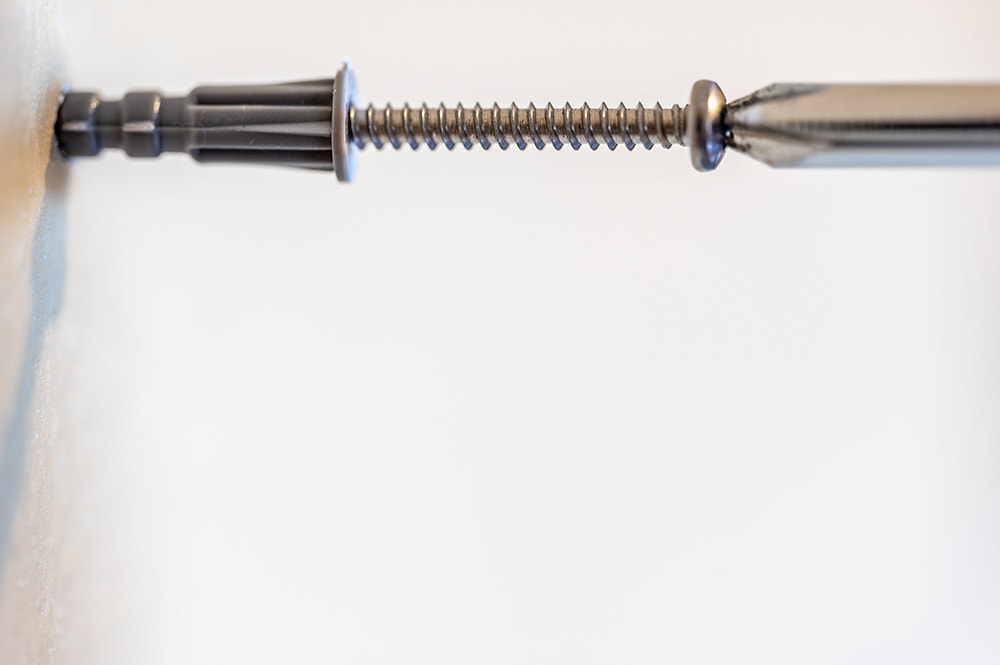
Here are several types of anchors with their hanging weight limits:
Expansion Drywall Anchors
Also known as a drywall plug, this anchor is less potent than other anchors and not recommended for hanging heavy items. Many lightweight wall hangings are provided with these plugs that once fastened, will expand to provide a tight grip.
Expansion drywall anchors aren’t suited to heavy wall fixtures and are not for lights or ceiling fans. The anchor is inexpensive and easy to install, and you can fix it without studs, as it won’t damage your drywall.
Threaded Drywall Anchors
Often made from metal or nylon, threaded anchors can support heavier things hung on your drywall as they’re more robust and thicker than expansion plugs. However, it’s not advisable to use them on ceilings, but they’ll hold up weights between 25 to 75 pounds with proper installation.
You won’t require special equipment to install a threaded drywall anchor since it’s sharp and pointed enough to drill a hole into the wall. They’re known as self-drilling anchors, as all you have to do is drive them gently using a screwdriver.
Hollow Plastic Drywall Anchors
You’ll need to drill a pilot hole first if you’re installing plastic plug anchors into your drywall. These are suited to light-hanging operations. Once the screw is fitted, the anchor’s plug expands and locks into position to hold 20 pounds, which is sufficient for holding up a shelf.
How Do I Know How Much Weight a Drywall Anchor Can Hold?
The last thing you want is to have your hangings falling off the wall or ripping out a part of your drywall due to too much weight. It’s essential to know how much weight your anchors will hold, which depends on the nails, screws, and studs you use.
With incorrect use of tools and hang locations, your drywall will support a few pounds at most, precariously. But with the proper installation, compressed gypsum board drywall will hold over 100 pounds of sheer or vertical weight.
Thinner nails or screws also drag or tear drywall, creating a large hole if you hang too much weight. You’ll need proper anchors, studs, and precise screw or nail placement to create enough strength and maintain larger weights.
Do More Drywall Anchors Hold More Weight?
You can use different types of anchors to secure weights onto your drywall; each has its unique way of securing. But altogether, anchors work to grip the wall and counteract the weight of a hung object, whether singularly or as a group.
Although it’s more complicated than scaling weight lineally, where two drywall anchors can hold up to 100 pounds, four will do the same for 200 pounds. The total weight you’ll support using more anchors depends on their size, location, drilling point spacing, and quality of your drywall material.
Anchor holes drilled too close together are counterproductive as they may cause points of weakness or cracks in drywall or supporting studs. As you add weight to the anchoring, further damage occurs, especially if your drywall is uneven.
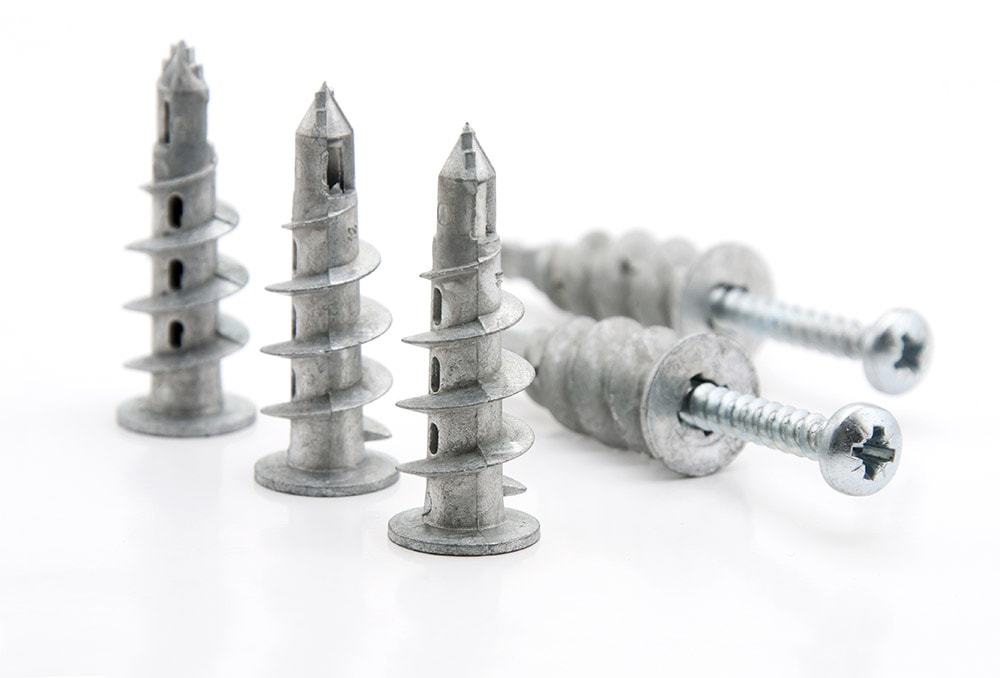
Can Drywall Anchors Hold a TV?
With solid nails or screws set in groups into your wooden or metallic wall stud, your drywall can support a TV depending on size and weight. You should multiply your anchor points to distribute the weight evenly if the set is heavy.
An average TV set weighs 32 pounds alongside its wall mount, and various mounts will accommodate this weight safely and comfortably. These include;
- Plastic drywall anchors with a capacity of 20 to 30 pounds and often threaded
- Plastic and metal winged drywall anchors with a 50 pounds weight limit
- Hollow drywall anchors made of plastic and metal with a capacity of 20-70 pounds
- Metal or plastic butterfly drywall anchors that handle 20 to 100 pounds
- Metallic self-driving drywall anchors for weights between 50 and 70 pounds
What Is the Strongest Drywall Anchor?
Toggle drywall anchors can support 100 pounds of hangings if you need heavy-duty holding power. They come in various designs, sizes, and materials, including plastic and metal but aren’t straightforward to install.
Toggle drywall anchors, especially those made of metal, require you to drill a hole three times wider than the diameter of the bolt. The self-driving anchors with wings will fold flat over the intersection to provide greater linear and tensile strength.
Tighten the bolt with a screwdriver while centering it inside the hole, and the wings will form a perpendicular brace on your drywall’s back side. While installation takes time and patience, you’ll be impressed by the holding power and firmness of the anchor.
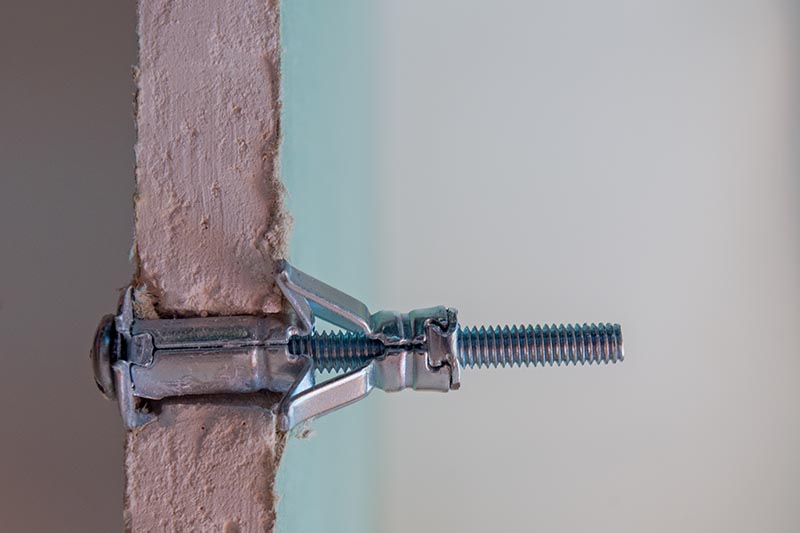
How Do You Insert Anchors in Drywall?
Drywall anchors can hold a considerable amount of weight when you use the right ones and install them properly. You’ll hang wall art like pictures, shelves, cabinets, light fixtures, and ceiling fans, or mount the TV by safely anchoring them to your walls.
When installing anchors, drive the screws or nails into the wall where studs are placed behind your drywall, often 16 to 24 inches apart. You can also use the correct type of anchor when you can find the studs, such as a self-drilling toggle variety.
- Get the right tools and materials such as a drill, hammer, screws, screwdriver, anchors, and measuring tape.
- After plotting your stud location, measure the holes and, for a tighter fit, make them slightly smaller than the anchor’s diameter.
- Insert the anchor into the hole until it’s flush with the drywall using a hammer.
- Screw in the base plate for mounting your light, fan, or TV and screw it into the anchor. If you’re hanging wall art, ensure you leave around ¼ of the screw’s head sticking above.
Conclusion
Despite its vulnerable and weak appearance, drywall can support a lot of wall adornments when installed correctly using the proper type of drywall anchors. They’re exceptionally innovative fastening supports that will hold up even the heaviest fixtures when well located, grouped, or compounded.
Drywall anchors have a tight grip on your walls’ pliable compressed gypsum board material, effectively counteracting the weight of hung objects. Once you’ve secured a connection, many anchoring ensembles will last long before the drywall requires replacing.
- https://www.arthitectural.com/how-much-weight-can-drywall-hold/
- https://www.remodelormove.com/do-more-drywall-anchors-hold-more-weight/
- https://www.yourbestdigs.com/reviews/the-best-drywall-anchors/
- https://bobsfinish.com/drywall-anchors-weight/
- https://www.albanycountyfasteners.com/blog/how-much-weight-can-a-drywall-anchor-hold/
- https://rethority.com/how-much-weight-can-drywall-hold/
- https://www.homereference.net/how-much-weight-can-drywall-hold/
- https://www.masterclass.com/articles/how-to-use-drywall-anchors
- https://www.realtor.com/advice/home-improvement/types-of-drywall-anchors/
- https://www.h2ouse.org/how-much-weight-can-drywall-hold/
- https://www.bobvila.com/articles/best-drywall-anchors/
- https://tilen.space/how-much-weight-can-drywall-anchor-hold/
- https://www.brownbox.ca/blog/dry-wall-anchors
Featured Image Credit: Shyjo, Shutterstock
Contents



